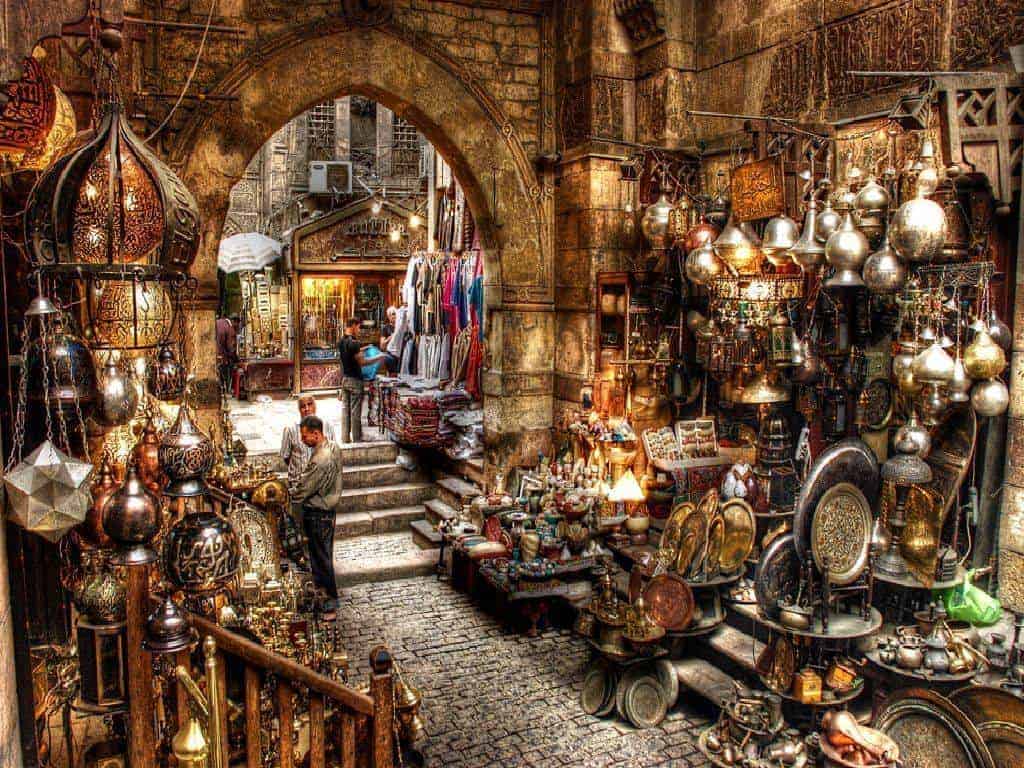In Cairo, the “City of a Thousand Minarets,” the namesake towers soar skyward amidst modern high-rises, while the grand pyramids loom in the near distance like gargantuan geometric colossi. Traffic snarls down Parisian avenues and around beautifully manicured maidans, pedestrians swarm labyrinthine side streets and souks, and calls to prayer fill the air from above. A population of roughly 20 million inhabitants breathe vitality into the harnessed chaos that is modern Cairo, the Egyptian capital abuzz with the vim and vigor of Middle Eastern life.
If you’re here as a student of history, your work is cut out for you: few cities on the planet offer such ready and constant exposure to the vestiges of times long gone. Cairo is a living museum of its near and distant past, with some remnants reclining in stoic ruin, and others still in regular use after many centuries of service.
And as a food lover on one of our Egypt best tours in 2019, you’re in luck. After a relative drought of many years, Egypt’s food scene has undergone a blossoming in the wake of the Arab Spring, with thousands of new restaurants budding up in the streets of the bustling metropolis since 2011. Many are born of the inspiration of global tastes—but others have looked to their roots, bringing Egypt’s culinary heritage to center stage in reverent homages and innovative expressions.
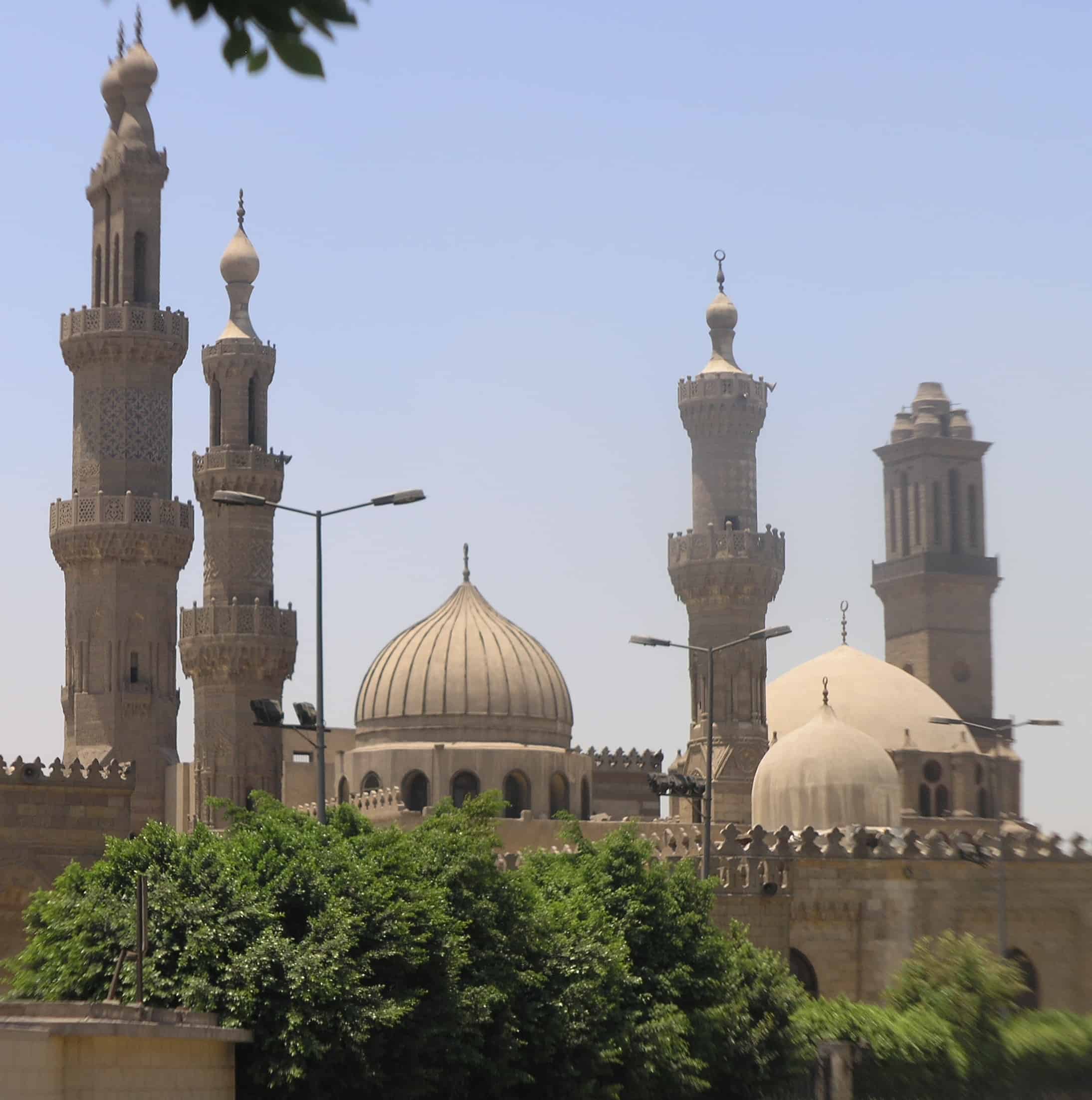
Cairo provides an overwhelming cornucopia of experiences to choose from—we’re happy to provide a more manageable selection of items to add to your itinerary, some plucked directly from the popular experiences on our luxury Egypt tours.
A Snapshot History of Cairo
Cairo’s history is a tale of conquest and perseverance—appropriately so, as its name carries the meaning of “the triumphant” or “the conqueror.” It was not the first or only settlement to command the Nile Delta, however. The antiquated capital of ancient Egypt, the city of Memphis, reigned first at the same spot for nearly 3,000 years, eventually fading upon the arrival of the Byzantine Empire. Competing Muslim factions conquered and were themselves conquered again, raising and razing settlements, cities, and fortresses over the ensuing centuries until the Fatimids established their new caliphate in al-Mansuriyyah in 968 A.D. Shortly renamed al-Qahiratu, “The Victorious,” it was another two hundred years before this young Cairo was made capital, following the defeat of the invading Crusaders.
Though not spared from its ravaging waves, Cairo survived the Black Plague better than many of its European contemporaries. It thrived as a hub of the spice trade, excelled in coffee and textiles, and established itself as a highly respected crucible of scholarly research, religious thought, and technological advance. Later shifts in rulers—Mamluk, Ottoman, French, British, and finally, the Egyptians themselves—did not shake Cairo’s grasp on the land, leaving the capital’s reign uninterrupted to this day.
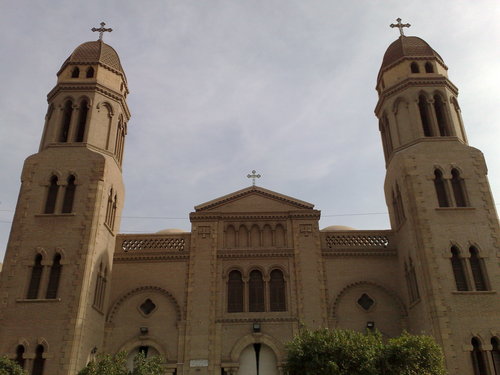
The Sights
Cairo wears its history openly—to walk the city streets is to walk through centuries of changing culture. Further afield at the city limits, even deeper journeys into the past await your curiosity.
Old Cairo
As the young city grew around the turn of the first millennium, Cairo subsumed the standing remains of the old capitals it succeeded. The venerable Coptic churches and fortresses of the Byzantine empire, the ancient mosques, and madrassas of former Fustat, al-Askar, and al-Qatta’i—all became the neighborhood of Old Cairo, itself now comprising Coptic Cairo and Islamic Cairo, with monuments of each chapter of its storied history still standing all about.
In Coptic Cairo, the Hanging Church of the 4th-century Romans remains in blessedly good shape and still holds regular prayer services some seventeen centuries later. The late-9th-century Mosque of Ibn Tulun in Islamic Cairo is the oldest mosque in the city, remaining in its original form, and is a gorgeous example of rare Abbasid architecture. The university (and associated mosque) of al-Azhar can be found here as well and is famed for elevating Cairo to a respected center of academic aspiration since its inception in the 10th century.
The Giza Complex
Not far from downtown Cairo in the Giza district rests the iconic and enormous monuments that are synonymous with the city and Egypt at large: the Great Pyramids and the Great Sphinx.
The most famous of the many pyramids, the Great Pyramid of Khufu, hoisted its weathered limestone bulk to a height of over 480 feet and reigned as the tallest construction in the world for four millennia after its completion in the 27th century B.C. It is the only Wonder of the Ancient World that has survived to the modern era, intact but for the polished casing stones that would once have made the pyramid a shining beacon under the desert sun.
Standing—or perhaps laying—in solemn guard beneath the pyramids is the enigmatic Great Sphinx. With the body of a lion and the stylized head of 4th-dynasty pharaoh Khafre, the limestone-hewn monument is the largest statue of its kind and faces due east to greet the rising sun.
The proud Sphinx is Khafre’s dominant and lasting legacy—while his imposing pyramid may seem at a glance to rise over the pyramid of his father, Khufu, it only appears so by standing on the tip-toes of elevated bedrock.
The very definition of a must-see sight, the Giza complex is a stop on all of our Egypt private tours.

Memphis
A short journey south along the Nile brings you to the ruins of the city of Memphis, the capital of the Old Kingdom of Egypt, for eight consecutive dynasties. Founded over five thousand years ago, the details of its origin are known only through legend. The stone foundations and scattered relics of its temples—the most prominent devoted to the craftsman-god Ptah—are nearly all that remain of the once-mighty city, now an expansive open-air museum. Some statuary and sphinxes remain on site, but others can be seen in the Museum of Antiquities downtown.
Saqarra
Established originally as a royal burial ground for Memphis, the necropolis of Saqarra remained in use for thousands of years for citizens of varying status. The vast complex is the site of many tombs and pyramids, most importantly the stepped Pyramid of Djoser. The oldest large-scale stone building in all of Egypt, the Step Pyramid dates to the 27th century B.C. and is thought to be the prototypical structure for the pyramids of subsequent dynasties.
Continued excavations in the area have brought to light several newsworthy finds in recent years, including the very recent discoveries of two previously unknown 4,000-year-old tombs.
Egyptian Museum
The Museum of Egyptian Antiquities in Cairo houses some 120,000 artifacts of Egypt’s former kingdoms and the largest assortment of pharaonic relics in the world. Royal statuary abounds; the personal effects of ancient Egyptians, both famous and unnamed, adorn the halls and display cases. The current state of the museum is quite dynamic, with many items being moved to the much-anticipated Grand Egyptian Museum and other displays outdated by evolving theories of Egyptology as new evidence is unearthed and pieced together. But if you’re after the best look at a massive collection of ancient Egyptian history, there’s simply no better place in the world than the Museum of Egyptian Antiquities in Cairo.
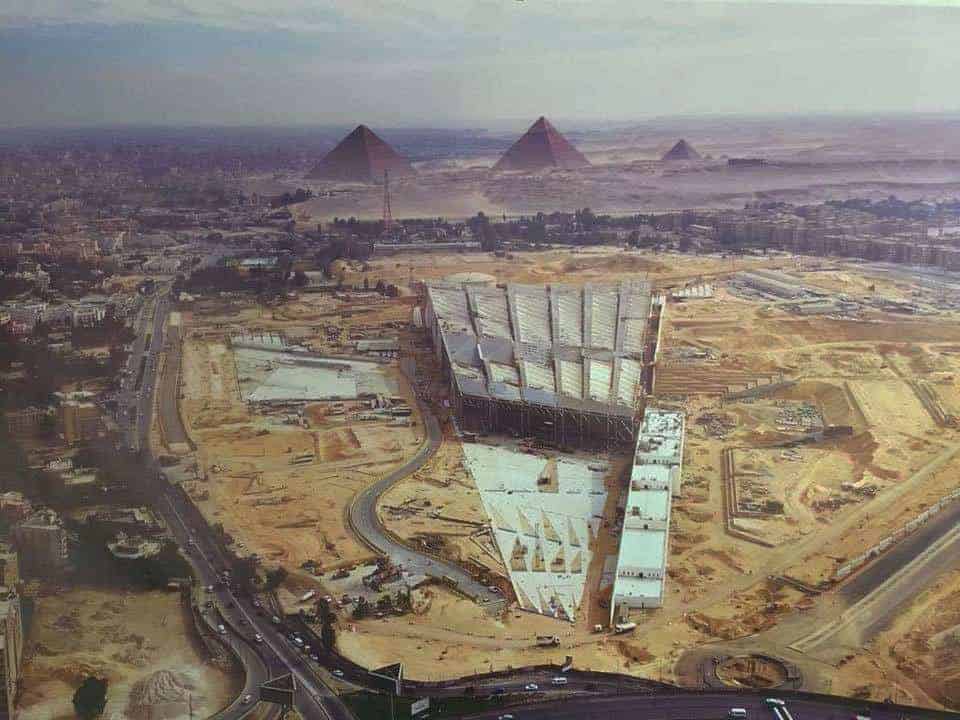
Khan al Khalili
The vibrant souk of Khan al-Khalili has been a delight to traders near and far since its inception in the 14th century. After two hundred years of organic growth around the Cairo Citadel, a major reconstruction in the 16th century gave the trading outpost a more permanent structure and regular layout still in use today. Hundreds of merchants hawk goods of all kinds, from ornate trinkets and intricate lamps to bold spices and teas. While souvenirs abound—especially in the more central areas—the Khan is also a go-to for everyday Cairene shopping. Make your way to the outskirts, preferably with a private guide, for more specialized and authentic goods.
The Bites
The Egyptian food scene has entered into a renaissance in Cairo, with traditional cuisine getting both modern updates and serious treatments. Here are a few of the best places to stop for a taste of Cairo.
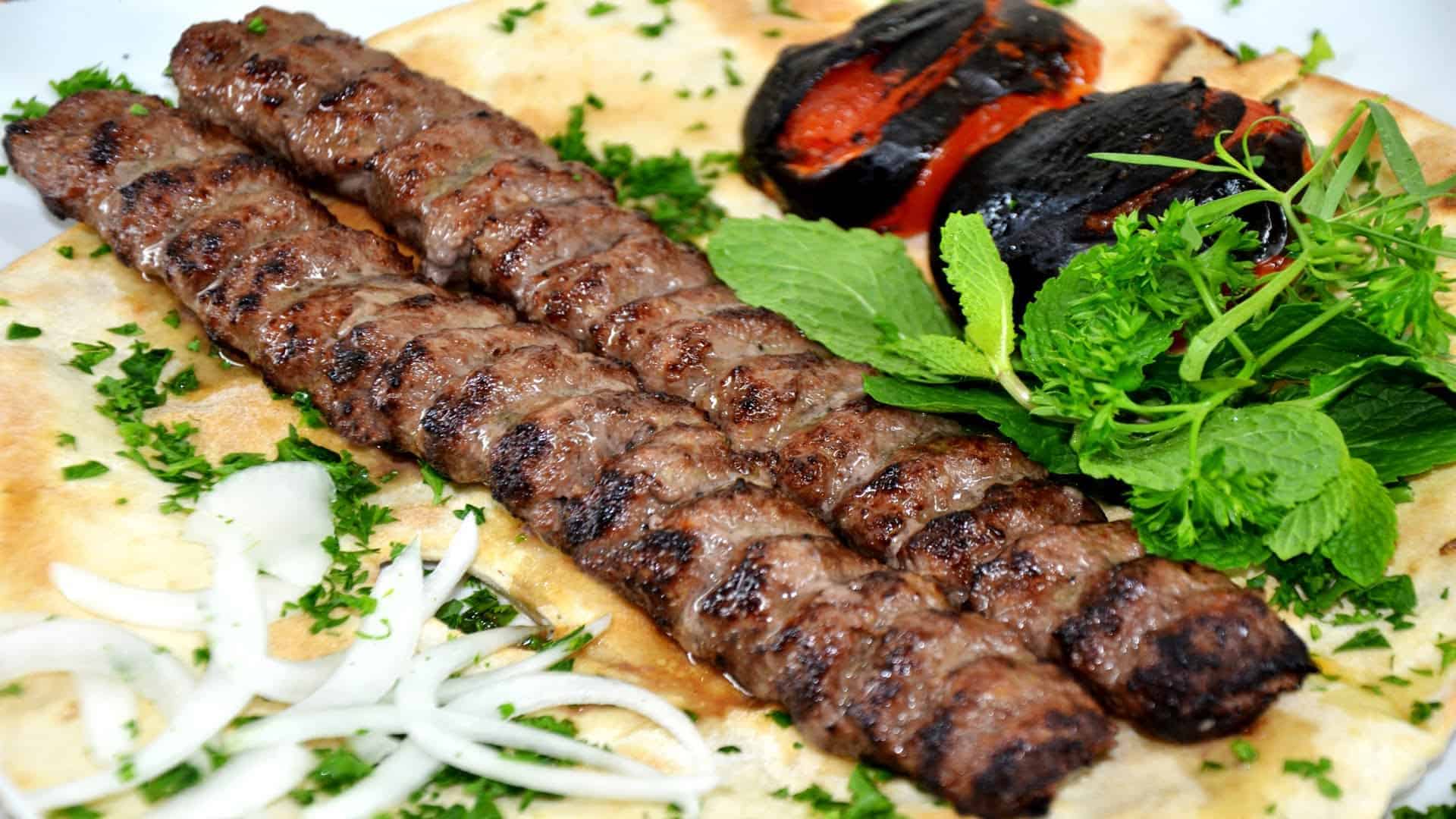
Naguib Mahfouz Cafe
If you haven’t over-stuffed yourself on bazaar snacks in Khan al-Khalili, this is the calm oasis to step into before you find your way out of the city’s bustling souk. Named for the Nobel-awarded Egyptian writer, the Naguib Mahfouz Cafe serves up authentic Egyptian food & drink in a comfortably informal atmosphere. Partake of shisha and mint tea, and nibble on ta’ameya—Egypt’s fava bean falafel—or slide into the adjoining restaurant for heartier fare. The relaxed but active vibe (and the free Wi-Fi) makes this an excellent mid-day respite from your adventures.
Fasahet Somaya
Though it has moved out of its hidden alley beginnings and onto a less by-passable street, this foodie gem still thrives on limitation. Sporting only a handful of tables, open for only a couple of hours most nights, and without a set menu (owner and chef Somaya picks over the daily markets and cooks up the choicest finds), Fasahet Somaya still teases Cairenes with the best of old-school Egyptian home cooking. Come early and come hungry—it can be hard to snag a seat after opening, and you might be chided for not finishing your mulukhiyah.
Zooba
Founders Chris Khalifa and Moustafa El Refaey opened their first Zooba in Zamalek in 2011 and never got the chance to look back. Taking classic Egyptian street food to the next level, Zooba is a fast-casual hit spreading throughout Cairo—and, soon, to New York City. Classic mezze is served quickly and fresh daily alongside bowls of creamy ful and beefy baladi sandwiches stuffed with hawawshi. Zooba is also a food-quality pioneer, adhering strictly to locally grown and additive-free ingredients.
Koshary Abou Tarek
You can’t eat in Egypt without at least a few bowls of koshary, and this is the place with the reputation for the best. The hearty national dish of Egypt comprises a flavor-packed mishmash of spiced lentils, savory rice, chickpeas, fried onions, and—oddly enough for an Egyptian street-food staple—macaroni. Topped with a vinegary tomato sauce, the dish begs for the addition of shatta, an assertive hot sauce to dare your tastebuds with. Abou Tarek, now a four-story restaurant, began as a food cart, the only kind of place that served koshari for years. If you can’t parse the local chatter on the lower floors, head up to the 4th story, where you’ll find ex-pats and tourists stuffing themselves on the cheap with the help of English-speaking waiters.

The Nights
After long days of adventure, sightseeing, and rib-sticking Egyptian fare, there’s nothing better to look forward to than Egypt’s world-famous hospitality in the best luxury hotels of Cairo. Here are a few places to best rest your bones—and to pack a little more meat on them, if you’d like.
Marriott Mena House
Once a privately owned and royal hunting lodge, the updated and expanded Marriott Mena House hotel has hosted a share of dignitaries in its lifetime— Franklin Delano Roosevelt and Winston Churchill, among others—owing both to its superb reputation and its enviable position beside the pyramids of Giza. Expect regal service and accommodations, as well as stunning views of the pyramids right from your room. The building itself is a marvelous combination of arabesque architecture and 19th-century English details, boasting exquisite and singular antiques among its amenities. It also premiered Egypt’s first swimming pool, which made a splash in 1890. Do not worry—the pool has also been updated.
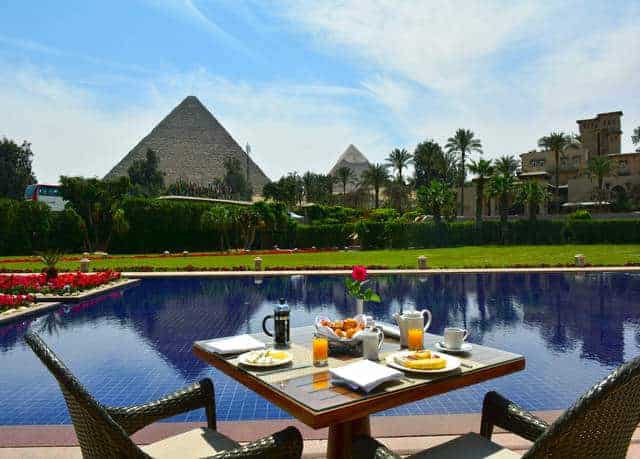
Four Seasons Nile Plaza
Situated along the bank of the Nile in the somewhat quieter neighborhood of Garden City, the high-rise Four Seasons Cairo at Nile Plaza offers luxurious accommodations with sweeping views of the city and pyramids alike. It’s also a lucky choice for good eating—the acclaimed Zitouni, serving upscale and authentic Egyptian fare, is but one of several in-house dining options.
Kempinski Nile Hotel Garden City Cairo
A frequent feature in our Egypt tour packages, the Kempinski Nile Hotel in Garden City is perfectly located for easy access to many of Cairo’s main attractions, like the nearby Museum of Antiquities and the Khan al-Khalili souk. Aside from its perfect blend of modern comforts and traditional charm, the hotel is particularly noted for its top-tier service and attentive staff. The on-site restaurant Osmanly is well-known for its outstanding Turkish cuisine and, moreover, for its signature dish with 17th-century Ottoman roots: Hünkar Beğendi.
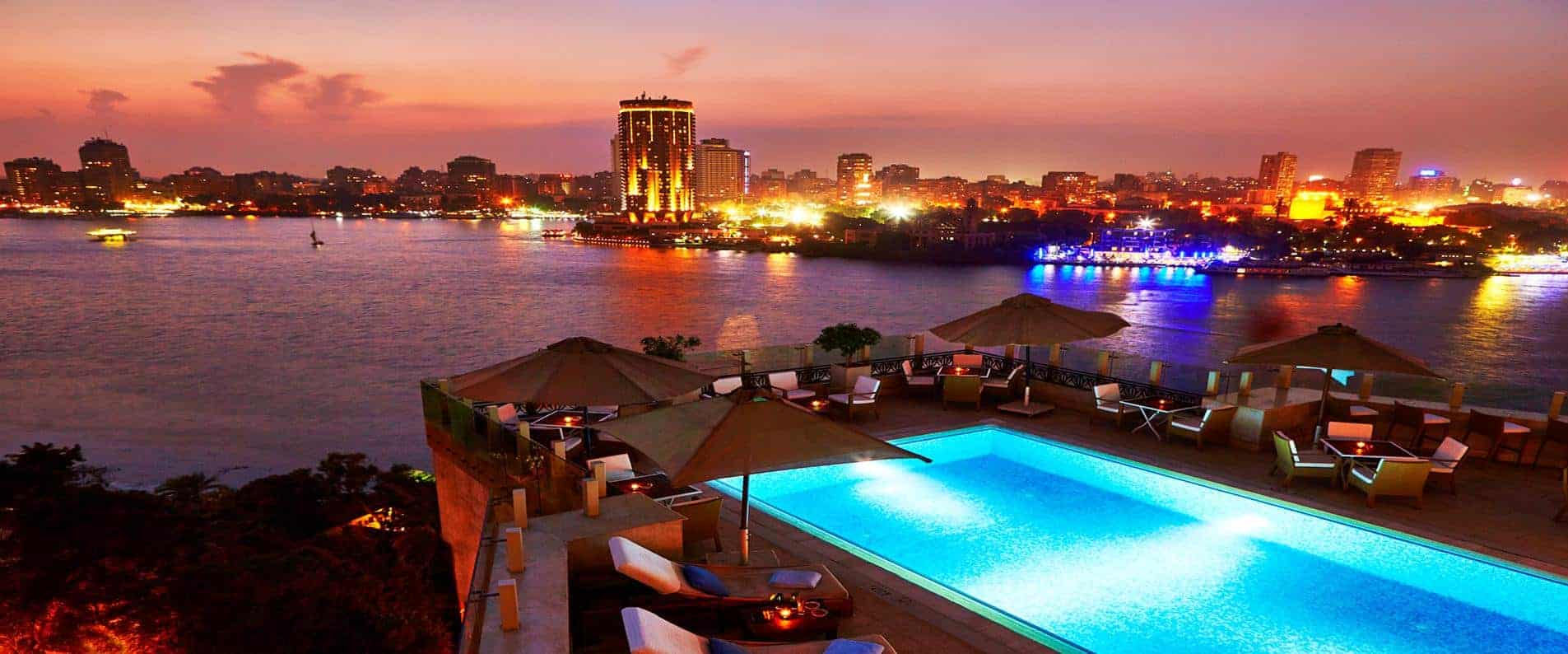
InterContinental Cairo Semiramis
If you’re looking for spectacular, five-star accommodations in the heart of downtown Cairo with an array of top-rated dining options on-site, you need to look no further than the InterContinental Cairo Semiramis. One of the tallest buildings in Cairo, the IC Cairo stands on the site of the former Semiramis Hotel, the first hotel to be built along the Nile in Cairo back in 1907. This modern incarnation is a gourmand’s dream: restaurants The Grill, The Birdcage, and Panne Vino—featuring modern French, Thai, and contemporary Italian cuisine, respectively—all make regular appearances on Cairo’s best-of-dining lists.
We look forward to you joining us soon on any of our Egypt luxury tours to Cairo and beyond. Do you like the guide, or have a suggestion on something we missed? Please leave a comment or connect with us on Facebook or Instagram.
Happy traveling!
